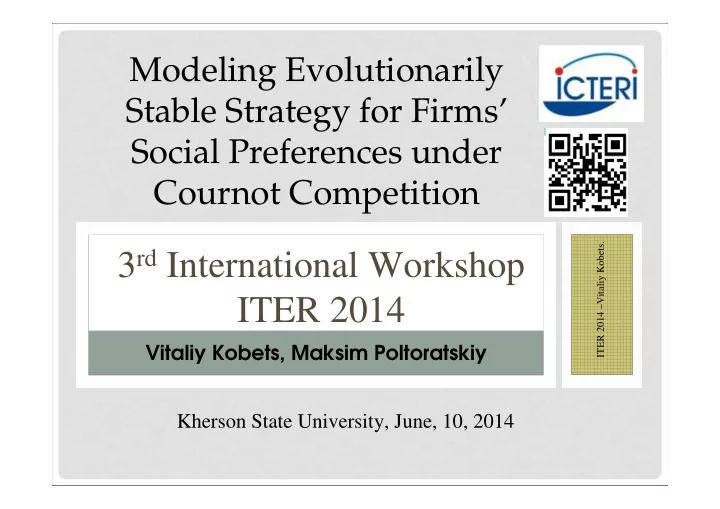

Modeling Evolutionarily Stable Strategy for Firms’ Social Preferences under Cournot Competition ITER 2014 –Vitaliy Kobets. 3 rd International Workshop ITER 2014 Vitaliy Kobets, Maksim Poltoratskiy Kherson State University, June, 10, 2014
Outlines • Motivation • Literature review • Research question ITER 2014 –Vitaliy Kobets. • Types of firms’ behavior • Competition model: assumptions • Competition model: preferences • Strategies’ selection: ESS vs non-ESS • Conclusions 2
Motivation • Traditional economics can explain: - Why firms’ selfish behavior is best strategy for supporting and increasing of his own profit; - Why cartel can increase profits of participants; ITER 2014 –Vitaliy Kobets. - Competitive equilibrium as result of ‘invisible hand’ BUT can not explain: - Altruist and punisher can also earn profits; - Firms which follow such model of behavior can gain more profit than selfish firm 3
Literature review Pro egoist behavior Contra egoist behavior • Individual is egoist: the • Behavior stays rational, more good he receives, when firm combines the more he benefits selfishness and social [Myerson, 1982] norms [McFadden, 2009] ITER 2014 –Vitaliy Kobets. • The benefits of one agent • Mutual gains from do not mean anything to cooperation generate the other [Filatov, 1998] altruism [Bowles, 2003] • Positive effect of • Punish behavior is more ‘Invisible hand’ [A.Smith] effective than egoism under strong social rules [Tanaka, 2000] 4
Interaction of people and institutions ITER 2014 –Vitaliy Kobets. 5
Research question • Question is why some attitude of firm to his rivals is unchangeable (constant), but others attitudes can change? More accurate: ITER 2014 –Vitaliy Kobets. • Paper goal is to investigate which social preferences of firms are evolutionarily stable strategy (do not change under impact of their rivals) under quantity competition on homogeneous product market 6
Types of firms’ behavior Cost/Benefit Private costs Private benefits Outsider Altruists Co-operators ITER 2014 –Vitaliy Kobets. benefits (Cartel) Outsider Punishers Selfish costs persons (Egoists) 7
Types of firms’ behavior selfish ( α =0): ≥ q π = ⋅ − ⋅ → P q v q 0 i max i i i i ITER 2014 –Vitaliy Kobets. altruistic ( α >0): ; ∑ ≥ π = ⋅ − ⋅ + α ⋅ π q → P q v q 0 i max i i i i i j ≠ j i punishing ( α <0): ∑ ≥ π = ⋅ − ⋅ + α ⋅ π q → P q v q 0 8 i max i i i i i j ≠ j i
Competition model 1: assumptions • n firms compete in quantity; • Linear market demand and the cost of competitors is common knowledge; • Each firm knows his own attitude and attitudes of others to ITER 2014 –Vitaliy Kobets. himself; • Firm selects an attitude giving for his profit more than average in industry; • Firm saves successful model of behavior as norms, rules or institutes. 9
Competition model 1: data ITER 2014 –Vitaliy Kobets. 10
Competition model 1: egoists’ attitudes ITER 2014 –Vitaliy Kobets. 11
Competition model 1: egoists’ profits ITER 2014 –Vitaliy Kobets. 12
Competition model 1: egoists’ quantities ITER 2014 –Vitaliy Kobets. 13
Competition model 2: altruists’ attitudes ITER 2014 –Vitaliy Kobets. 14
Competition model 2: altruists’ profits ITER 2014 –Vitaliy Kobets. 15
Competition model 2: egoists’ quantities ITER 2014 –Vitaliy Kobets. 16
Competition model 3: altruists’ attitudes ITER 2014 –Vitaliy Kobets. 17
Competition model 3: altruists’ profits ITER 2014 –Vitaliy Kobets. 18
Competition model 3: egoists’ quantities ITER 2014 –Vitaliy Kobets. 19
Competition model 3: price ITER 2014 –Vitaliy Kobets. 20 Economics 20 - Prof. Anderson
Competition model 3: quantity ITER 2014 –Vitaliy Kobets. 21
Conclusions • “Selfishness" attitude is not an evolutionarily stable strategy (ESS) • The attitude of "altruism" is ESS if altruist have higher productive efficiency (e.g., lower average costs) under competition with selfish firm. But if a firm with lower ITER 2014 –Vitaliy Kobets. average cost is less altruistic, then the two are eventually transformed into punishers and "altruism" is not ESS in such case. • The attitude of "punisher" is also ESS if punisher has higher productive efficiency (e.g., lower average costs) under competition with altruist. But if a firm with smaller average cost is lower punisher, the two firms become altruists and "punisher" is not ESS in this case. 22
Recommend
More recommend